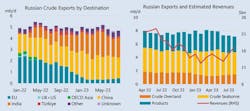Russian oil export revenues surge in August on higher prices
Russian oil export revenue increased by $1.8 billion in August to its highest level since October 2022, according to latest estimates from the International Energy Agency (IEA). While overall exports fell by 150,000 b/d month-on-month (m-o-m), the weighted average price of Russian crude increased by $9.30/bbl (+14.4%), IEA said.
According to IEA’s estimates, Russian crude oil export revenue increased by $1.4 billion m-o-m, while product export revenue increased by only $400 million. Overall, estimated export revenues remained $1.6 billion below year-ago levels.
Total oil exports fell by 150,000 b/d m-o-m, with a 120,000 b/d m-o-m rise in crude exports more than offset by a 270,000 b/d m-o-m decline for products. Total shipments in August were 900,000 b/d below pre-war levels and down 570,000 b/d year-on-year (y-o-y).
“Crude volumes were marginally higher with declines in seaborne trade to China more than offset by increased exports to India. China and India still buy the majority of Russian crude. However, their combined share has eroded to 75% in August versus an average 81% from January to May 2023 as other buyers have emerged,” IEA said.
Russian crude prices above the price cap in August do not appear to have significantly impacted destinations, according to IEA.
Outbound product trade fell m-o-m for vacuum gas oil (VGO, -100,000 b/d), fuel oil (-50,000 b/d) and gasoil (-65,000 b/d), while a rise in gasoline (+28,000 b/d) partly offset the continued fall in naphtha exports (-70,000 b/d). The trends reflect, in part, the end of maintenance on downstream units, bringing back online conversion capacity and reformers, according to IEA. The largest declines y-o-y are for naphtha (-125,000 b/d) and fuel oil (-160,000 b/d) that are only partially offset by increased exports of gasoline and gasoil (+80,000 b/d each).
Product exports remain robust to the UAE, India, and Brazil, but have fallen to Saudi Arabia and China. The monthly decline in product shipments appears to have impacted mainly the Middle East (-240,000 b/d), but this could increase still once the destination of the 250,000 b/d of product headed to “unknown” destinations is ascertained.
Flows eased m-o-m to Turkey (-25,000 b/d to 470,000 b/d) and India (-20,000 b/d to 120,000 b/d) but remained flat to Africa (320,000 b/d). China, India, Turkey, and the Middle East take roughly a third of Russian product exports, in some cases using it to displace domestic supply which they export instead.
Russian government revenues from oil (in US dollars) rose 26% m-o-m in August (+33% in rubles) but remained 33% lower y-o-y (+4% y-o-y in rubles), reflecting the falling exchange rate (-6% m-o-m, -56% y-o-y). August’s rise in export revenues signals a further increase in fiscal revenues in September. The government subsidy to refiners for domestic diesel and gasoline deliveries will drop by 50% from September, which will offset some of the y-o-y losses in government fiscal receipts, IEA said.
